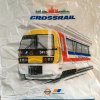Following on from the thread on BR loco plans that never happened at www.railforums.co.uk/threads/br-diesel-and-electric-locomotive-plans-that-never-happened.230760/ I wondered if there were many types of DMU or EMU that were proposed but never built.
This can also include further batches of existing unit classes that were planned but never built, or classes of which only a solitary prototype or small prototype fleet was built and a production series fleet was planned but never saw the light of day.
Again I am mainly interested in the BR era (1948-93) but this can also include examples from the pre-nationalisation or post-privatisation era.
Offhand I can think of four examples (well, four classes of unit) from the early 1990s, just before privatisation:
The Class 371, 381 and 471 Networker EMUs: according to Wikipedia the 371s were planned for Thameslink 2000, the 381s for the London Tilbury and Southend lines from Fenchurch Street and the 471s for the Kent Coast routes. The 471s were planned to have 1st class compartments in a side corridor layout, and I believe that a mock-up of the 471 was put on display on the concourse at London Victoria.
Another fleet of Networkers (can't remember what class they were to be known as) was planned for Crossrail before the Crossrail project was shelved in the early to mid 1990s.
If you include further batches of existing fleets, I seem to recall that BR planned to order a further fleet of 323s for West Yorkshire but that plan was abandoned because of privatisation. Instead West Yorkshire got ex-Network SouthEast Class 307s and 308s until the 333s were built in the early 2000s.
And if you include examples from the pre-nationalisation era, I believe that the LMS planned to rebuild Euston station in the early 1940s if WW2 hadn't happened, and as part of this scheme they were going to order a fleet of sliding door EMUs for the Watford DC lines. Of course, about 15 years later the DC lines got the slam-door 501s instead (and these were eventually replaced by sliding-door 313s in the mid-1980s).
This can also include further batches of existing unit classes that were planned but never built, or classes of which only a solitary prototype or small prototype fleet was built and a production series fleet was planned but never saw the light of day.
Again I am mainly interested in the BR era (1948-93) but this can also include examples from the pre-nationalisation or post-privatisation era.
Offhand I can think of four examples (well, four classes of unit) from the early 1990s, just before privatisation:
The Class 371, 381 and 471 Networker EMUs: according to Wikipedia the 371s were planned for Thameslink 2000, the 381s for the London Tilbury and Southend lines from Fenchurch Street and the 471s for the Kent Coast routes. The 471s were planned to have 1st class compartments in a side corridor layout, and I believe that a mock-up of the 471 was put on display on the concourse at London Victoria.
Another fleet of Networkers (can't remember what class they were to be known as) was planned for Crossrail before the Crossrail project was shelved in the early to mid 1990s.
If you include further batches of existing fleets, I seem to recall that BR planned to order a further fleet of 323s for West Yorkshire but that plan was abandoned because of privatisation. Instead West Yorkshire got ex-Network SouthEast Class 307s and 308s until the 333s were built in the early 2000s.
And if you include examples from the pre-nationalisation era, I believe that the LMS planned to rebuild Euston station in the early 1940s if WW2 hadn't happened, and as part of this scheme they were going to order a fleet of sliding door EMUs for the Watford DC lines. Of course, about 15 years later the DC lines got the slam-door 501s instead (and these were eventually replaced by sliding-door 313s in the mid-1980s).

